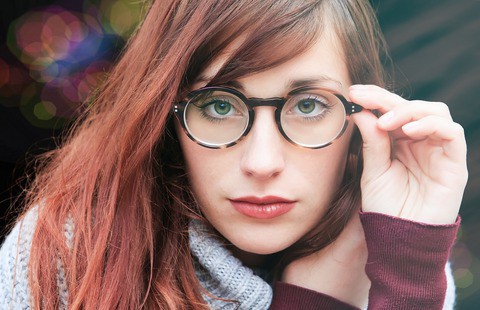In short, it is your life, and it is your telescope, you can do whatever you want. However, in reality, it is a little more complicated than that, but the quick answer is…
Yes, however, the glass or plastic of the corrective wear can diffuse and distort the light coming into your eye. If your eyes are bad, you may have trouble with the ability to focus the telescope. Plus, any astigmatism will add to a blurry or distorted view as well.
So what does that mean, and what can we do about it? Let’s dive into what, why, and how to possibly solve for corrective wear when using a telescope.
What are the Limiting Factors
Astigmatism
This condition is familiar to many people with corrective wear. It is a condition of your eye not being a spherical shape anymore and more the shape of a lemon that pulls and distorts your view. The view distortions are typically toward the outside edges of your vision.
Typically, the exact center of your vision is not affected by astigmatism. I will explain a little better in a bit, but limiting the field of view, or more specifically, creating a smaller exit diameter improves this.
Eye Relief on the Eyepieces
Eye Relief is how far from your eyepiece your actual pupil has to be. This can be a problem on higher power magnifications because your eyeglasses will restrict your pupil from getting close enough to the eyepiece.
Again, further down, I will talk about the ways to improve and possibly eliminate this.
Exit Pupil Diameter on Eyepieces
This is the diameter in millimeters of the amount of light coming out of the eyepiece. The average human eye is 7-9 mm when fully dilated, hence “dark vision.” This does decrease with age. Below, we will talk about this and how to fix possible problems with corrective wear by adjusting the exit pupil diameter.
An easy way to describe this would be by specifying it as, Having a view the size of a quarter, but only using a dime’s space of it.
Can I Solve for Astigmatism?
This mostly depends on how severe or minor your astigmatism might be. However, astigmatism usually is the outside diameter of your pupil that gets distorted from the stresses from the shape of the eye, not being symmetric and spherical.
Sometimes people don’t even realize they have astigmatism because it is very slight. Sometimes astigmatism is very severe, and You need specific corrective wear to correct the distortions of the eye.
So, Can I Compensate for Mild Astigmatism?
Yep, a simple way to compensate for this is to use a large diameter eyepiece; for example, I have two 25mm eyepieces; one is a super Plossl, the is a cheaper Plossl. The nicer one has a glass view diameter of 24mm, and the cheaper one has a glass view diameter of 14mm. Negating for a moment that the one is better quality, we should use the super Plossl with the 24mm view diameter.
Then we should take and calculate the exit pupil diameter to be, for example, 5mm in diameter with a typical 7mm dilated pupil.
You can also use a Barlow lens to help magnify the image to use the lower power quality eyepieces. Check out the Best Barlows article.
What this example did was eliminate distortions of the eyepiece perimeter, and create a smaller diameter for your eye to view, so your own eye would not distort the view either with astigmatism.
How To Check if it is Blurry Because of Astigmatism or Because of the Eyepiece.
A quick way to check on the eyepiece is to find a bright star. Center it in your view and slowly rotate the eyepiece to see if the blemish “distortion” moves with the eyepiece or if it stays at the same location.
Using a wide field-of-view eyepiece and keeping the magnification to a point where the exit pupil diameter is smaller and prevents astigmatism from affecting the edges of the view.
What Eye Relief Should I Use with Glasses or Contacts?
In short, as large as you possibly can with corrective wear needs. Even without corrective wear trying to keep your eye steady at a high powered eyepiece, like a 6mm, can be a delicate task before also adding corrective wear to the mix.
One way to increase eye relief is by using a Barlow lens. This way, you can increase magnification but still use a wide and longer focal length eyepiece. With glasses, you’ll probably need at least 15 mm of eye relief and if you can shoot for more all the better.
Eye relief is closely related to Max Exit Pupil, and the limits of the eyepiece itself.
Pupil Diameter related to age based on Glasgow University’s research
| Age (years) | Pupil Size (mm) |
|---|---|
| 1-20 | 7.5 |
| 21-30 | 7.0 |
| 31-35 | 6.5 |
| 36-45 | 6.0 |
| 46-60 | 5.5 |
| 61-80 | 5.0 |
How to Calculate Eye Relief
Pupil Diameter x Focal Ratio (of your telescope)
Example using a common selling telescope PowerSeaker 127 EQ and my age bracket pupil dimater:
5.5 x 8 = 44mm
OK, We Need to Talk about Exit Pupil Diameter Too, Right?
Yes, the exit pupil is the diameter of light we’ll say that goes out the eyepiece toward your eye. A dilated pupil on a human being is typically 7 to 9 mm. Therefore you want to try and get an exit pupil that is larger than 7 mm and not smaller than 7 mm, so you’re using your whole eye. Older folks may find they only have 5 – 6mm or so. See table above
The trick here is, and of course, to have 7mm of the image in the eyepiece, however with astigmatism and Imperfections in the eyepiece itself near the edge can distort and blur views. What some guys do here is make their aperture of the tube smaller.
This can be achieved by creating a donut ring that will create a smaller aperture, thus a smaller exit pupil diameter. The problem here is you are blocking light. The whole idea of a telescope is to gather light. But seeing a crisp image even if it is a little dimmer may be a big win over a blurry brighter image.
How to Calculate Exit Pupil Diameter
Aperture / Magnification = Exit Pupil Diameter
Focal Length / Telescope Focal Ratio = Exit Pupil Diameter
To get to my telescope calculator, click here.
Does Nearsighted (Myopia) or Farsighted (Hyperopia) do Better?
I need to keep testing this more, however, if you are nearsighted, you should be able to use the focus of your telescope with the eyepieces. You may be collecting light from far away, but you only need to focus on like 2 to 3 inches from your face where the image converges.
The opposite side is farsightedness, and here you will have to wear your glasses to be able to focus your eye within that 2″ to 3″ range.
Of course, if you’re older and need reading glasses to boot, that pretty much means, and depending on the power of the reading glasses, you will have to wear them as well. Most users of reading glasses are in the 1.5X to 3X power, which means you’re focusing adjustment should be able to compensate.
Quality of Your Lenses in Your Glasses
Just like in telescopes, you can get special coatings and materials to reduce refractive properties in the lens. If you are one of those persons that need to wear your glasses, you can upgrade on your glasses.
Just like in refractor telescopes, you can upgrade to an APO lens. I haven’t been to the eye doctor for a while, but you may be able to get an idea of lens types here
Glassesusa plus, they have a 65% off coupon for first-time users clicking this link!
Need More?
Being someone who does need corrective wear lenses, and as in my case, contacts are 95% of the time, I thought this would be an excellent article to share. To further help your astronomy endeavor, you may want to look at these articles too…
Magnification Where Does It Get Blurry


